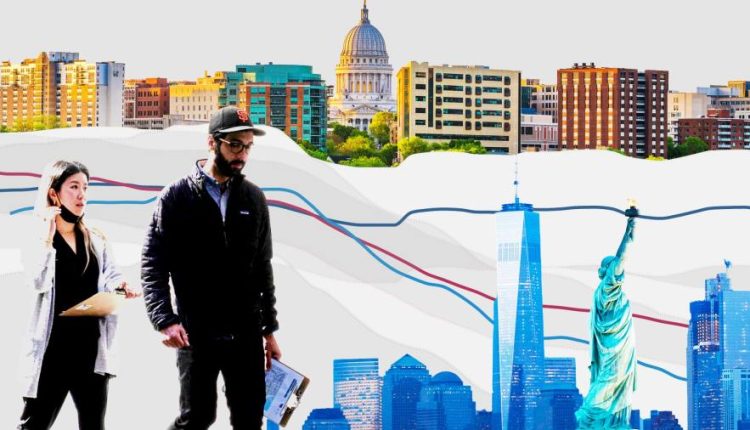Receive free US economy updates
We’ll send you a myFT Daily Digest email rounding up the latest US economy news every morning.
The fortunes of downtown areas in the US have diverged since the onset of the coronavirus pandemic, new research shows, with one class of cities largely restored to vibrancy and another emptier and more forlorn.
The differences are tied to a city’s size, according to a paper by economists at Georgetown University and the University of Chicago. Using mobility data from smartphones, housing prices and other factors from 274 US cities, the researchers found that central business districts in smaller cities were more likely than larger ones to have returned to pre-pandemic activity.
The implications — for commercial real estate values, local tax receipts and street life, among others — are serious. Larger cities’ business districts seem “stuck” in this new world, said Ferdinando Monte, an economist at Georgetown and co-author of the study.
The economists found that Covid-19 shocked the fragile equilibrium that made large cities’ downtown areas thrive. People put up with inconvenient commutes and congestion to experience the personal interaction and the exchange of ideas found in major urban centres.
The benefits require others to make the same cost-benefit calculation: people prefer to work downtown if others are working downtown, when the benefits are high, but otherwise stay home when the benefits are low.
The lockdowns of the pandemic, coupled with the forced adoption of remote work, suddenly removed many of these benefits. Now that working from home has persisted, it has made it difficult to bring a critical mass of people together again in larger cities such as New York, Los Angeles and San Francisco.
As a whole, the largest US cities, defined in the paper as those with more than 1.5mn employees, have stabilised at about 60 per cent of their pre-pandemic downtown foot traffic. The economists quantified this phenomenon using phone mobility data and shared portions of it with the Financial Times.
In smaller cities the pre-pandemic balance has largely come back, according to the study. One explanation is that occupations concentrated in these downtowns are more likely to require in-person work, while the potential benefits of personal interaction were always lower because of the mix of industries present.
“That’s part of the reason why those small cities were small in the first place — there was no need, for what they were doing, to agglomerate,” Monte said. “Those interactions were not as important as they were in New York.”
Taken together, the mix of occupations and industries in a given city, along with other costs and benefits of working in an office — from commute times to the value of personal interactions — all played a part in differentiating smaller cities from large metropolises in terms of post-pandemic downtown recovery, according to the paper.
Sam Chehade, owner of Michelangelo’s Coffee House in downtown Madison, Wisconsin, said business started to pick up in 2022 and is now surpassing pre-pandemic sales. “We’re pretty solid — we’re back,” he said.
Madison, the state capital of Wisconsin and home to the main campus of its public university system, is a smaller US city. Traffic in the downtown area was also “increasing quite a bit”, Chehade said.
In New York, statistics remain depressed across the board. Subway ridership stands at 65 per cent of pre-pandemic levels, in what the city has called “an enduring legacy of the Covid-19 pandemic”. Weekday office occupancy in the metro area is still less than half of what it once was. Tourism this June was down 11 per cent from June 2019, according to pandemic recovery data-tracking from local news outlet The City.
“I think it’s a double-edged sword, to be honest,” said Rob Sadow, co-founder of Scoop, a hybrid-work software company. “Cities that have been most aggressive in adopting work-location flexibility are some of the ones that have the most struggling downtowns”, including San Francisco.
These two divergent paths also express themselves in home prices. In big cities, the premium people are willing to pay to live close to the city centre has declined steadily since the pandemic, according to the research. In smaller cities, the premium has bounced back. The price of a house within a central business district relative to those in the suburbs has fallen and never recovered in large cities. The economists used zip-code-level data from Zillow.
The research briefly touched on measures that might influence the return to central business districts, such as a government tax on remote work. “It’s really hard to talk about the future,” Monte said. But “it’s been three years now, and that line doesn’t seem to move”.
Whatever was lost in the central business district might now be found elsewhere. Sadow of Scoop said: “I think that in a lot of metros it is breathing new life into the non-downtown areas where people live and work, and it’s helping local retail, keeping people in those areas more often and democratising within a metro access to opportunity. I think it will do that not just within metros but across the country.”
Is this new normal good for the general welfare, or has something dear been lost? “The benefits from the lack of commuting compensate for most of the losses,” the economists wrote.
Read the full article here

